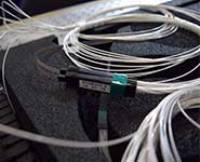Oct 10 2013
With optical fibre networks gradually approaching their theoretical capacity limits, new types of fibres such as multicore fibres have been at the focus of worldwide research to overcome critical capacity barriers, which threaten the evolution of the Internet.
The University of Bristol in collaboration with the National Institute of Information and Communications Technology (NICT) have demonstrated successfully for the first time a multicore fibre-based network, which will form the foundation for the future Internet infrastructure.

The research relies on Space Division Multiplexed (SDM) provided by the multicore fibres and on Software Defined Network (SDN) control, which are considered promising solutions to fulfil and control the ever-increasing demand for data consumption in communication networks.
This collaborative work between the High Performance Networks Group at Bristol and NICT, Japan, represents the first successful demonstration of a fully functional multicore fibre network taking advantage of the flexibility and intelligence that SDN can offer in order to provide services to emerging Internet applications such as global cloud computing.
The Bristol research team developed the SDN control based on extensions of the OpenFlow protocol and provided the novel network node equipment while NICT contributed multicore fibres (MCFs) and new transmission techniques based on self-homodyne detection (SHD).
The implemented OpenFlow interface dynamically configures the network nodes in a way that the network can deal more effectively with application specific traffic requirements such as bandwidth and Quality of Transport.
With the growing popularity of OpenFlow, this demonstration is believed to bring multicore fibre networks one big step closer to their practical realisation.
Professor Dimitra Simeonidou, Head of the High Performance Networks Group at the University of Bristol, said: “Although most on-going research has been concentrating solely on the improvement of data throughput and transmission distance of point-to-point links, it has become apparent that the success of new fibre technologies will be strongly governed by its applicability to optical networks together with an adequate control of all required network functions.
“From the viewpoint of network control, Software Defined Networking (SDN) has been recently gaining increasingly attention as a technology that enables network operators to easily adapt their network infrastructure to quickly changing user or application requirements and improve network efficiency. Up to now, however, SDN has been applied only to optical networks based on single-core fibres and therefore restricted to the capacity bottlenecks of the current fibre infrastructure.”
In the future, Bristol and NICT hope to further improve their network technologies on both the software and hardware side and work with network operators to demonstrate the practical realisation of multicore fibre networks.
The results of the demonstration were selected for presentation as a prestigious post-deadline paper at the European Conference and Exhibition on Optical Communication (ECOC) in London last month (September 26).